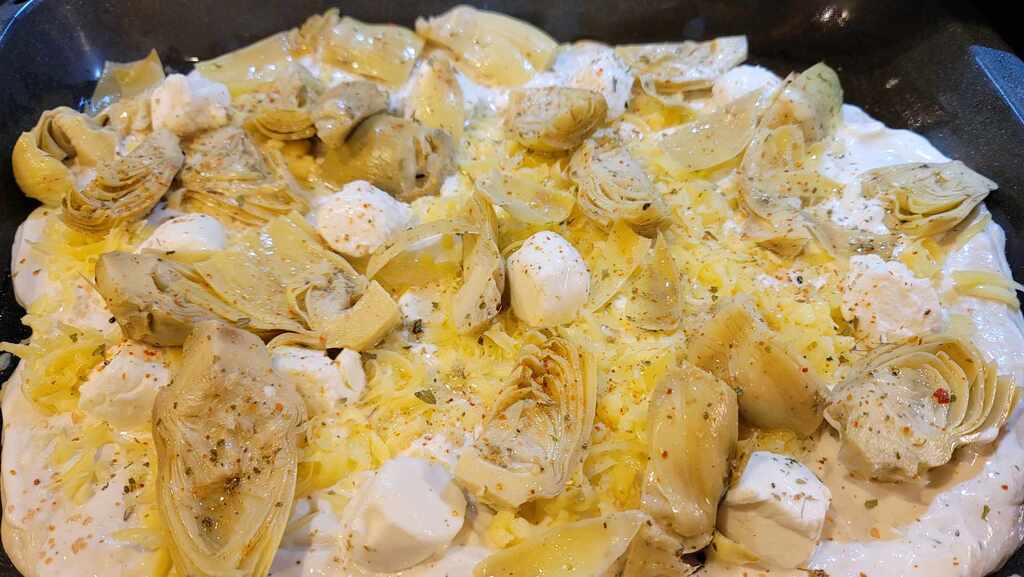Making pizza from scratch is a rewarding experience, especially if you are using a live yeast starter to create the crust. The hearty flavor of a homemade pizza crust along with a good quality sauce and your favorite toppings are a surefire way to impress your family at dinner time.
Why Use a Live Yeast Starter?
You might be wondering why we aren’t using instant yeast here. It is certainly easier to store and quicker to use, but a fresh yeast starter has its own merits. The texture and flavor of your pizza crust are so much better when made this way. The pizza crust will be chewier and the taste will be better than any pizza dough made with instant yeast.
A live yeast starter, also known as a sourdough starter, only requires you to mix together flour and water. After a couple of days, the starter will start to bubble, which signifies the wild yeast is beginning to multiply. After a few more days, it is ready to be used in baking.
Wild yeast is present in flour, but it needs to be mixed with water and allowed to sit for a while in order to activate and start to multiply in the mixture.
How to Make the Live Yeast Starter
All-purpose flour is fine, but you can use any kind you want, including whole-grain, whole-wheat or rye. If you are new to this, go with all-purpose flour because it gives the most predictable result.
The whole process takes around five days, but the exact timing depends on the conditions in your kitchen. Once you see signs of yeast activity and bubbles, you will need to ‘feed’ the starter to keep it active.
Ingredients
4 oz (¾ cup plus 2 tablespoons) all-purpose flour
4 oz (½ cup) filtered water
A digital scale or measuring cups
2-quart plastic or glass bowl (don’t use metal)
A clean kitchen towel or plastic wrap
Method
Carefully weigh out your flour and water, then combine in the bowl, stirring well until you have a smooth batter. Use a clean kitchen towel or plastic wrap to loosely cover the bowl, and put it somewhere with a temperature between 70 and 75 degrees F. Leave it alone for 24 hours.
Have a look at the starter. You might see little bubbles already, which means the wild yeast is starting to activate, eating the sugars present in the flour and releasing carbon dioxide bubbles and alcohol. You might not notice any bubbles yet, and that is fine. Sometimes it just takes longer.
Weigh out another 4 ounces of water and flour and stir them into the starter. Cover it up again and let it sit for another 24 hours. By now you should notice bubbles and a slight increase in volume, as well as a musty, yeasty smell.
Add another 4 ounces of water and flour into the mix, cover, and leave for another 24 hours. Keep repeating this for 5 days or until your starter has doubled in bulk and has a lot of bubbles.
To maintain the starter, you will need to discard or use about half of the mixture, while replacing it with more flour and water.
Where to Keep Fresh Yeast Starter
You can leave it on the countertop if you will be using it within the next few days, else it can be kept in the refrigerator. The countertop starter should be fed daily, while the refrigerated starter only needs feeding once a week because the cold temperature slows down the whole process.
How to Make the Pizza Crust
You will need unfed starter for this, meaning whatever you are removing from the bowl of yeast starter before adding more flour and water to maintain it. Along with that, we are using water, flour and a little oil and salt to make the dough.
Ingredients
1 cup homemade active yeast starter
3 cups bread flour
1 cup warm water
1½ teaspoons salt
2 tablespoons olive oil
Cornmeal, for dusting
Method
Use a mixer to combine the starter with 2 cups of flour and the water, then cover and set aside for an hour. Mix again, adding the oil, salt, and remaining flour. You can use a dough hook attachment if you have one. Turn up the speed and knead for 5 minutes. You can also do all of this by hand.
Shape the dough into a ball and put it in a lightly oiled bowl, turning so it is coated with oil. Cover and leave for 30 minutes, then uncover and fold the dough into itself a few times. Cover and repeat after another 30 minutes, then cover and repeat an hour later, and again an hour after that.
At the end of 3 hours, the dough should be stretchy and airy. You can give it another hour if not. Cut the dough into 2 and shape it into balls, then cover and rest for 20 minutes.
Now flatten it and press it into a crust shape using your hands, stretching it as you go. Don’t use a rolling pin or you will deflate the bubbles and the texture of the dough will not be so good.
Put each crust on a cornmeal-sprinkled pizza pan, spread your favorite pizza sauce on top and add your preferred toppings, then grill or bake the pizza until the cheese (if using) has melted and the crust edges are golden brown.
If you are grilling it, give it about 10 minutes over direct medium heat with the lid down. If you prefer to bake it, give it about 15 minutes at 450 degrees F. You will see when the pizza is ready! Let the pizza cool for 5 minutes or so before cutting into it.




